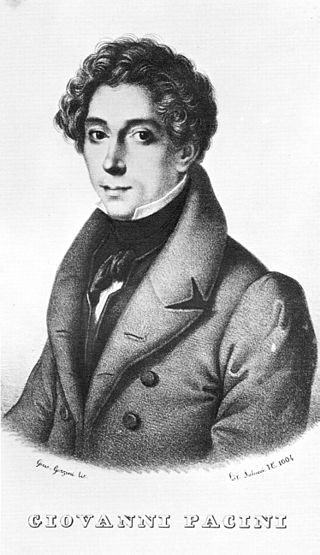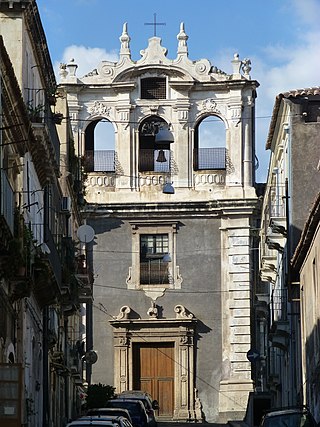
Giovanni Pacini was an Italian composer, best known for his operas. Pacini was born in Catania, Sicily, the son of the buffo Luigi Pacini, who was to appear in the premieres of many of Giovanni's operas. The family was of Tuscan origin, living in Catania when the composer was born.

Catania is the second largest municipality in Sicily, after Palermo. Despite its reputation as the second city of the island, Catania is the largest Sicilian conurbation, among the largest in Italy, as evidenced also by the presence of important road and rail transport infrastructures as well as by the main airport in Sicily, fifth in Italy. It is located on Sicily's east coast, at the base of the active volcano, Mount Etna, and it faces the Ionian Sea. It is the capital of the 58-municipality region known as the Metropolitan City of Catania, which is the seventh-largest metropolitan city in Italy. The population of the city proper is 311,584, while the population of the Metropolitan City of Catania is 1,107,702.

Giovanni Carmelo Verga di Fontanabianca was an Italian realist (verista) writer, best known for his depictions of life in his native Sicily, especially the short story and later play Cavalleria rusticana and the novel I Malavoglia.
The primary languages of Calabria are the Italian language as well as regional varieties of the Neapolitan and Sicilian, all collectively known as Calabrian. In addition, there are 100,000 speakers of the Arbëresh variety of Albanian, as well as small numbers of Calabrian Greek speakers and pockets of Occitan.

The Villa Marlia or Villa Reale di Marlia is a late-Renaissance palazzo or villa, and its estate's property that includes renowned gardens and adjacent villas and follies within the compound. It is located in Capannori, in the Province of Lucca, west of Florence, in the northern Tuscany region of Italy.

The Giardino Botanico "Nuova Gussonea" is a botanical garden located at an altitude of 1700 m on the southern side of Mount Etna, in area B of the Etna Natural Park, Ragalna, Province of Catania, Sicily, Italy. It has a surface of about 10 hectares.

The flora of Italy is all the plant life present in the territory of the Italian Republic. The flora of Italy was traditionally estimated to comprise about 5,500 vascular plant species. However, as of 2019, 7,672 species are recorded in the second edition of the flora of Italy and in its digital archives Digital flora of Italy. In particular, 7,031 are autochthonous and 641 are non native species widely naturalized since more than three decades. Additionally, further 468 exotic species have been recorded as adventitious or naturalized in more recent times.

The Giardino Bardini is an Italian Renaissance garden of the Villa Bardini in the hilly part of Oltrarno, offering fine views of Florence, Italy. Opened only recently to the public, it is one of Florence's well kept secrets.

Villa Sciarra is a park in Rome named for the villa at its centre. It is located between the neighborhoods of Trastevere, Gianicolo and Monteverde Vecchio.

The Giardino Bellini is the oldest urban park of Catania.

Monastero di Santa Lucia is an architectural complex in the town of Adrano, in the Province of Catania, region of Sicily, Italy. The former Benedictine monastery currently serves as an elementary school, and attached to it is the Giovanni Verga high school. In front of the facade is a polygenal public park known as either Giardino della Vittoria or Villa Comunale.
The following is a timeline of the history of the city of Catania in the Sicily region of Italy.

The Amphitheatre of Catania is a Roman amphitheatre in Catania, Sicily, southern Italy, built in the Roman Imperial period, probably in the 2nd century AD, on the northern edge of the ancient city at the base of the Montevergine hill. Only a small section of the structure is now visible, below ground level, to the north of Piazza Stesicoro. This area is now the historic centre of the city, but was then on the outskirts of the ancient town and also occupied by the necropolis of Catania. The structure is part of the Parco archeologico greco-romano di Catania.

Asmundo is an old Sicilian noble family that has played a notable role in the island's political, cultural, and economic history.

The Baths of the Rotonda are the remains of one of several Roman public baths in the city of Catania, Sicily. Built between the 1st and 2nd century CE, they are not far from the Roman theatre and the odeon. In the Byzantine era, the church of Santa Maria della Rotonda with its characteristic dome was built upon the remains of the Roman baths. Its walls are still covered in medieval and baroque frescoes.

Luigi Pacini was an Italian opera singer who appeared on the principal stages of his native country as well as in Spain and Austria in a career that spanned over 30 years. He began his career as a tenor but in 1805 started singing bass roles and rose to prominence in that repertoire. Amongst the numerous roles he created in world premieres were Geronio in Rossini's Il turco in Italia and Parmenione in his L'occasione fa il ladro. Pacini was born in the Province of Pistoia and died in Viareggio where in his later years he taught singing at the conservatory founded by his son, Giovanni Pacini.

The Conservatorio delle Verginelle di Sant'Agata is a former orphanage-hostel and church located on via Teatro Greco #82, with the northern facade paralleling Piazza Dante and the Monastery of San Nicolo l'Arena in the center of the city of Catania, region of Sicily, Italy. Presently it houses the facilities of the Faculty of the Scienza della Formazione of the University of Catania, educating future science teachers.

The Villa Cerami was once a semirural villa, located at the edge of the urban center and with a sizable surrounding garden, located at the Northern end of via Crocifero (#91), in the city of Catania, Sicily, southern Italy. Once a private home, it now houses the offices of the School of Jurisprudence (Law) of the University of Catania. It is located on a rise above the city, the villa was built atop the ruins of part of the Roman amphitheater of which some ruins are visible in nearby Piazza Stesicoro. Adjacent or nearby are three Sant'Agata churches: la Vetere, al Carcere, and alla Fornace. The route down via Crocifero passes four major Baroque churches and convents.
Alexander Hardcastle was a British archaeologist, who supervised archaeological work in Sicily, restoring the Greek Temples of Agrigento.
















